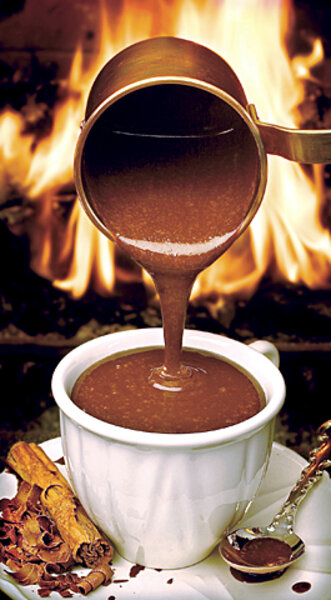Three Parisian paths to bliss
Loading...
Sitting under the green awnings of Les Deux Magots, reveling in the long history of literary patrons who frequented one of the Left Bank's most famous cafes – Oscar Wilde, Jean-Paul Sartre, and Ernest Hemingway, among others – we said to ourselves, "if only we had something as important to write about as they did."
Then it came.
Our orders of hot chocolate – chocolat chaud – arrived alongside a delectable herbes-de-Provence omelet. Pouring the thick, brown elixir out of a perfect china pitcher – and tasting its explosion of cocoa essence – we agreed on a mission: Find the most sublime chocolat chaud in Paris.
Ten days later, we would sit in these same two chairs, with our ever-expanding ratings chart (intensity, texture, consistency, flavor, sweetness, bouquet) and realize a mission accomplished.
Scouring the restaurant and cafe guides, interviewing patrons and cafe owners, visiting the best in Paris (Fauchon's, Fouquet's, Maxim's, Café Florio, and more) – and, most important, tasting these heady, mousse-thick brews ourselves – we had our answer, loud and clear and unanimous.
"Ladurée," said one, mentioning the pastry shop on Rue Bonaparte.
"Café Angelina's," said the other, mentioning her best friend's recommendation from Rue de Rivoli.
Well, we proved at least that consensus is impossible where taste is concerned. We thought of backtracking for a second sip of each to settle it. But our time was up so we had to move on, back to the United States, where hot chocolate is just another hot beverage.
We interviewed cooks and waitresses and other patrons and took voluminous notes, which can be lumped into three lingering observations:
One style is for the restaurant to hand-mix each cup from cocoa powder, sugar, and hot milk – as was done at Les Deux Magots. This is typically served with tubettes of sugar to sweeten what often arrives as a thick, bittersweet confection.
A second method – explained after great prodding of our waitress at Café Angelina's – is to use a house blend, a predetermined sugar-cocoa mix blended by machine, which produces a consistent, if not unique, consommé/pottage/purée. This toothsome brew won't speak to those who like their chocolate "dry," but for those whose tastes run to the mind-bendingly sweet, it goes down like a melted soufflé.
The third was shared with us by chief chocolatier Arian in the basement of the newly opened Chocolate Museum of Paris.
Dismissing the use of "poudre" – particularly any preblended, sugar/cocoa mix – with a classic French shrug, she shares her method: Take roughly a dozen pastilles (coins) of fine semisweet chocolate (per cup), melt them into "extremely hot" milk, then spice to taste with beaucoup de spices – vanilla, cloves, cinnamon, and pepper.
She pointed out the museum's No. 1-listed factoid: "The Aztec emperor, Moctezuma, used to drink up to 50 cups of spicy cocoa a day."
Now back in the US, complete with raw powder, perfect two-cup pitchers, and a hand-held Cuisinart mixer, we're concocting our own brews almost weekly, derived from a combination of these three schools, wondering if we can even match Moctezuma's intake in a year.
Each time we make it up, we repeat the postsip rating ritual that we launched in Paris (designed to keep each other honest, rock/paper/scissors style): On the count of three, give your rating…





